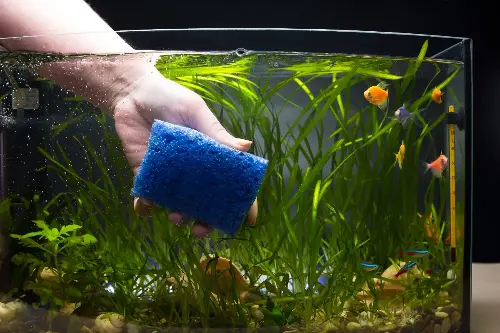Creating an underwater utopia in your own home can be as enchanting as it is tranquil. Sparkling waters, vibrant fish, and lush aquatic plants not only bring life to any space but also a sense of calm and wonder. However, the splendour of a fish tank is highly dependent on the cleanliness of its environment. Keeping your tank sparkling and your finned friends thriving requires attention to detail and a little know-how.

The Essentials of Tank Maintenance
Regular maintenance is the cornerstone of a healthy aquarium. It's not just about keeping the water clear; it's about creating an ecosystem where your aquatic companions can flourish. To begin with, ensuring your water quality is paramount. It's recommended to do partial water changes of about 25-30% every two weeks. This helps remove nitrates and phosphates, which can build up in the water and are harmful to fish.
When you remove water, make sure to treat the new water you're adding to the aquarium to remove chlorine, which is toxic to fish. Using a water conditioner is a simple way to achieve this. Also, check the water’s pH levels, hardness, ammonia, nitrite, and nitrate levels regularly with a testing kit. This keeps the water parameters aligned with the needs of your specific fish species.
Filtration: The Heartbeat of Your Aquarium
A robust filter is an indispensable part of any healthy aquarium. Think of your filter as the heart of your fish tank—constantly pumping and cleaning to keep the water fresh. There are three types of filtration: mechanical, chemical, and biological. Mechanical filtration catches the debris, while chemical filtration uses activated carbon to remove impurities, and biological filtration provides beneficial bacteria that process fish waste. Replace or clean the filter media as recommended, but never all at once, as this can disturb the delicate balance of beneficial bacteria.
Substrate Scrupulousness
The substrate, the layer lining the bottom of your tank, can house a surprising amount of waste material that contributes to water pollution. Vacuuming the gravel during your water changes is an effective way to remove food debris and feces. Sand substrates can be lightly stirred to prevent the buildup of harmful gases and promote a clean tank.
The Great Algae Challenge
Algae growth is a common challenge in many aquariums, yet it's also a sign of a healthy aquatic environment. However, unchecked algae growth can hinder plant growth, obscure your view, and deplete oxygen levels at night. Algae scrapers and magnetic cleaners can help keep the aquarium walls clean. Including algae-eating fish like plecos or snails can also naturally manage algae levels.
Plant Care and Placement
Plants play a pivotal role in an aquarium, providing oxygen for your fish and a filter for toxins. Prune dead leaves regularly to prevent decay and potential water quality issues. Ensure that your plants are root-rinsed before being introduced into the tank, which helps prevent the spread of parasites or diseases. The placement of plants is also key—they can act as hiding spots for fish and barriers to break the line of sight, which can reduce stress and aggression among tank inhabitants.
The Seasoned Aquarist’s Schedule
Establishing a routine for tank maintenance is essential. Create a checklist and schedule that includes regular feeding, water changes, filter checks, plant management, and health checks for your fish. This habit ensures nothing is overlooked and your aquatic ecosystem remains in balance. A little effort on your part goes a long way when it comes to the health and happiness of your tank's residents.
Engagement is Key
Despite the high standards of cleanliness, it's vital for fish to be engaged in their environment. Providing a variety of caves, tunnels, and plants for them to explore fosters a stimulating environment. Additionally, changing the layout of your tank once in a while can also contribute to increased mental stimulation for your aquatic pets.
A pristine tank is more than just visually pleasing; it's an essential aspect of your aquatic pets' well-being. With just the right blend of regular maintenance, proper filtration, a diligent cleaning regimen, and an environment that caters to their natural behaviour, your fish will not only survive but truly thrive. Embrace the process, and you'll find that maintaining the sparkling waters of your aquarium is not just a chore—it's an incredibly rewarding hobby that allows you to cultivate life and beauty within your own living space.
